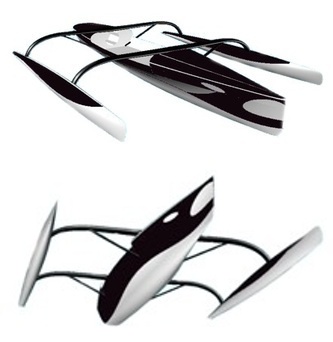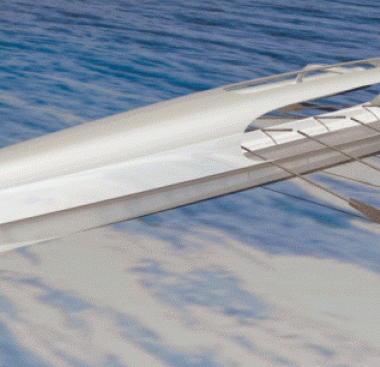Ocean Rowing Multihulls
When sheer efficiency is required, it’s hard to beat a multihull. The trimaran configuration is gaining traction in open ocean rowing events and according to proponents, the tri has some considerable advantages over monohulls. Here are a few that have crossed the desk recently.
Samson
Samson is a two-position rowing machine designed to make the 3800 mile (6,116 km) Atlantic crossing from New York to Paris. The brainchild of experienced rower Andras Bakos, the porpoise-like vessel measures 13.4 x 2.9 meters (43.9 x 9.5 ft) and has a dry weight of 650 kg (1,433 lb). Andras will be joined by New Zealand-based expedition partner Erik Harrewijn for the crossing, which is expected to take 60 to 80 days. Support the effort via their indigogo campaign.
Triantula
The Ocean Rowing Club of the Atlantic will be campaigning Triantula, a 60 ft. trimaran in two upcoming ocean rowing events, an Atlantic crossing speed record attempt in April 2016, and a World Cup race scheduled for the following November. Roy Finley, the boat builder and designer, says:
Triantula has a beam of under 4 feet, extremely long and narrow therefore minimal “wetted surface” requiring less power. The advantage the multi-hull has over the mono is mainly stability and lighter as we ensure the beams and amas (pontoons or ballast) weigh less than the ballast of a mono-hull of half the length. It could actually be said, the bigger the multi-hulls become the more of an advantage they have over mono-hulls.
Kurt Hughes Rowing Trimaran
Seattle-based designer Kurt Hughes has a 60 ft. rowing trimaran on the computer screen that he designed in 2012, but was never built. He claims some impressive numbers with the design, and I can’t help but think it would make an ideal Race 2 Alaska challenger. Well… almost ideal. A single outrigger could be even better!




